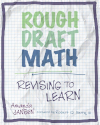- About MAA
- Membership
- MAA Publications
- Periodicals
- Blogs
- MAA Book Series
- MAA Press (an imprint of the AMS)
- MAA Notes
- MAA Reviews
- Mathematical Communication
- Information for Libraries
- Author Resources
- Advertise with MAA
- Meetings
- Competitions
- Programs
- Communities
- MAA Sections
- SIGMAA
- MAA Connect
- Students
- MAA Awards
- Awards Booklets
- Writing Awards
- Teaching Awards
- Service Awards
- Research Awards
- Lecture Awards
- Putnam Competition Individual and Team Winners
- D. E. Shaw Group AMC 8 Awards & Certificates
- Maryam Mirzakhani AMC 10 A Awards & Certificates
- Two Sigma AMC 10 B Awards & Certificates
- Jane Street AMC 12 A Awards & Certificates
- Akamai AMC 12 B Awards & Certificates
- High School Teachers
- News
You are here
Rough Draft Math

Publisher:
Stenhouse Publishers
Publication Date:
2020
Number of Pages:
224
Format:
Paperback
Price:
35.33
ISBN:
978-1625312068
Category:
Monograph
[Reviewed by , on ]
Karen Bump
05/29/2021
Robert Q. Berry III (NCTM President from 2018-2020) wrote the Foreword to Amanda Jansen’s book Rough Draft Math: Revising to Learn. Dr. Berry explains that he was first introduced to Amanda Jansen’s idea of ‘Rough Draft Math’ at a conference presentation under the name ‘Rough-Draft Talk.’ He supports rough draft math as a form of discourse which some call ‘exploratory talk,’ and uses it in his own classes. Dr. Berry III sees rough draft math as a way to encourage students' mathematical reasoning. Jansen chose to use “Rough Draft” instead of exploratory talk. The phrase ‘rough draft’ is commonly used in Language Arts. This phrase provides a level of comfort when used in mathematics classes. Students understand that the phrase ‘rough draft’ implies unfinished work.
The main focus of Rough Draft Math: Revising to Learn is the promotion of mathematical competency through meaningful discourse. The book is comprised of six chapters. Chapter one explores what is rough draft math. This is the chapter where Jansen defines rough draft math as a discourse, and where students share ideas that are unfinished. Chapter two presents the theoretical underpinnings as constructivism. This chapter also presents how to create a classroom culture that allows for nonjudgmental discourse that is a necessary part of rough draft math. Chapter three presents multiple tasks that allow for rough draft mathematical communication. This chapter explains the importance of students explaining their thinking. Chapter four explores how rough draft math is a revision structure where students become aware of their thinking process and how it may have shifted. The chapter also presents how solutions, ideas, and reflections can support a revision structure. Chapter five presents the idea of rough draft math as rehumanizing the mathematics classroom. Amanda Jensen references the notion of ‘rehumanizing mathematics’ as presented by Rochelle Gutiérrez (2018). The final chapter, chapter six, contains Amanda Jansen’s reflections on how she has incorporated rough draft math into her own classes. Jansen talks how it is a work in progress and rough draft math does not need to be used for every lesson and there are multiple ways to implement rough draft math.
The book is geared toward a practitioner audience. This would be an excellent resource for K-12 teachers. The book presents actual mathematical problem-solving examples. There are multiple vignettes of a variety of teachers from different grade levels using rough draft math. Jansen not only presents vignettes where everything works but also when the attempt at using rough draft math goes wrong. Jansen does not leave it as a presentation of what could go wrong but also offers suggestions on how to reorient the rough draft math experience with reflections on how to improve the experience.
The book has some discussion of formative assessments. Jansen also promotes the use of standards-based grading and portfolio assessments to complement the use of rough draft math. The book does not offer a deep dive into the overall notion of assessments or state testing and how rough draft math would affect students’ ability to perform successfully.
The book offers relevant examples that teachers can use in their classrooms. The vignettes, which showcase students’ conversations with one another, and with the teacher are invaluable. Jansen offers views into various classrooms throughout for K-12 and even post-secondary classrooms that feature preservice mathematics teachers. Jansen gives compelling reasons to use rough draft math to increase students’ conceptual learning.
Karen Bump is a doctoral student at the University of North Texas.
Karen Bump is a doctoral student at the University of North Texas.
The table of contents is not available.
- Log in to post comments




